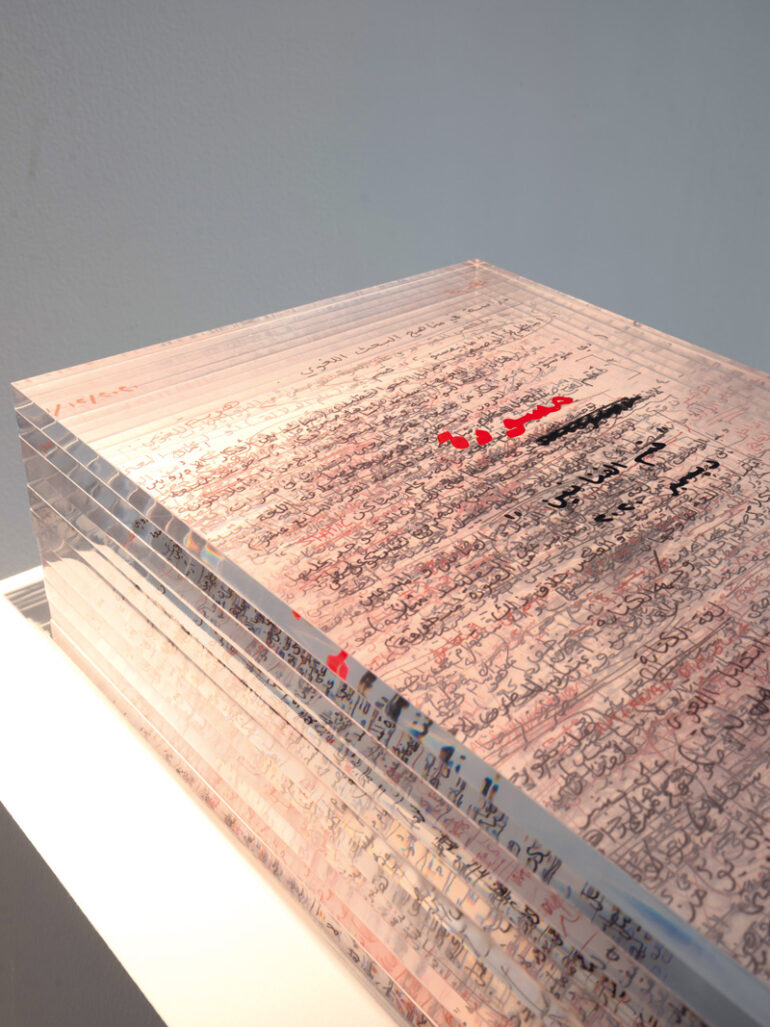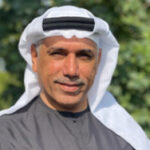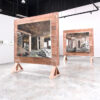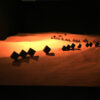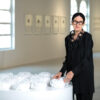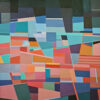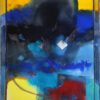The artworks lead the viewer to face the question of truth and existence, with the word “right” representing the core of what philosophers sought to find.
In the artwork titled (Artist’s Oath), the artist practices what is thought to be a deliberate demolish of time continuity.
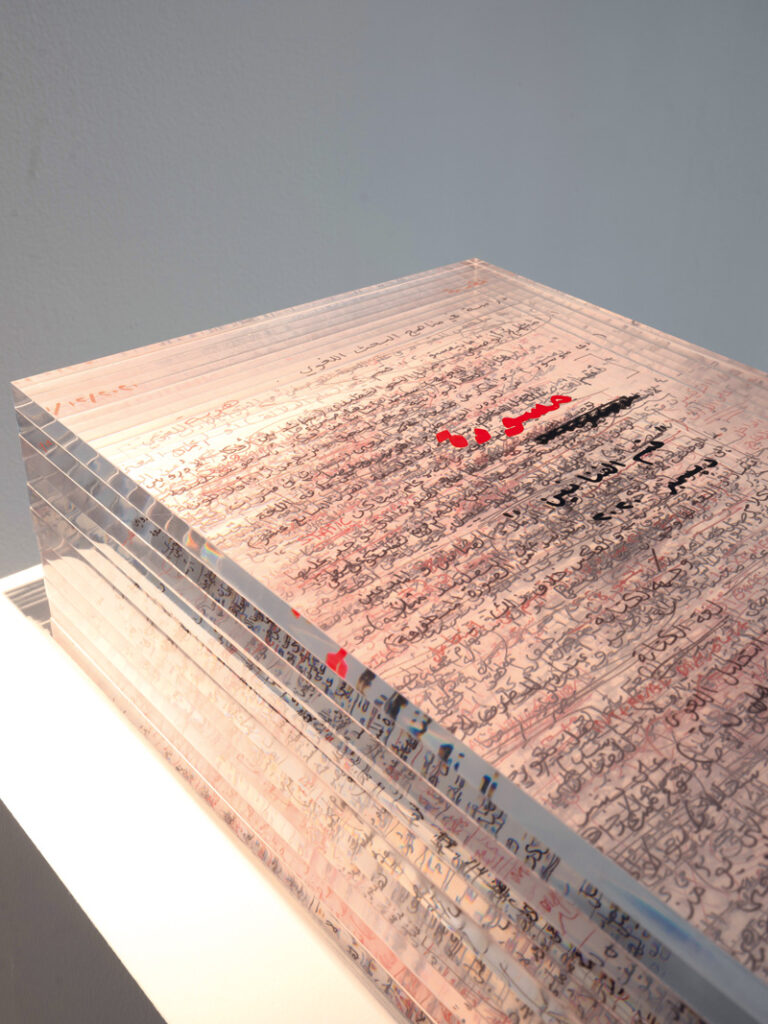

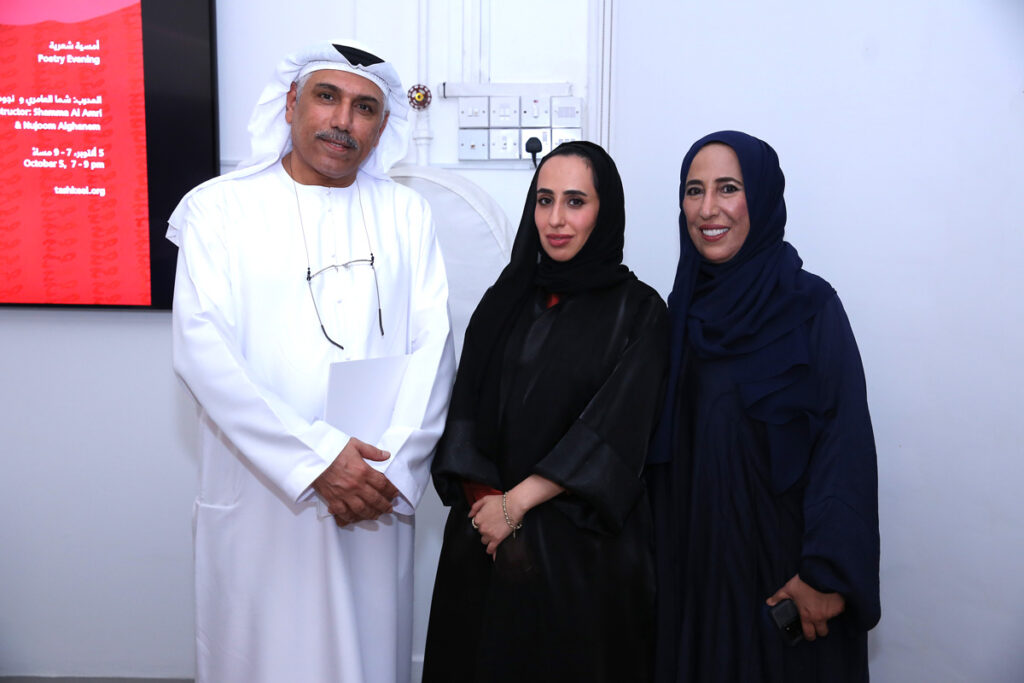
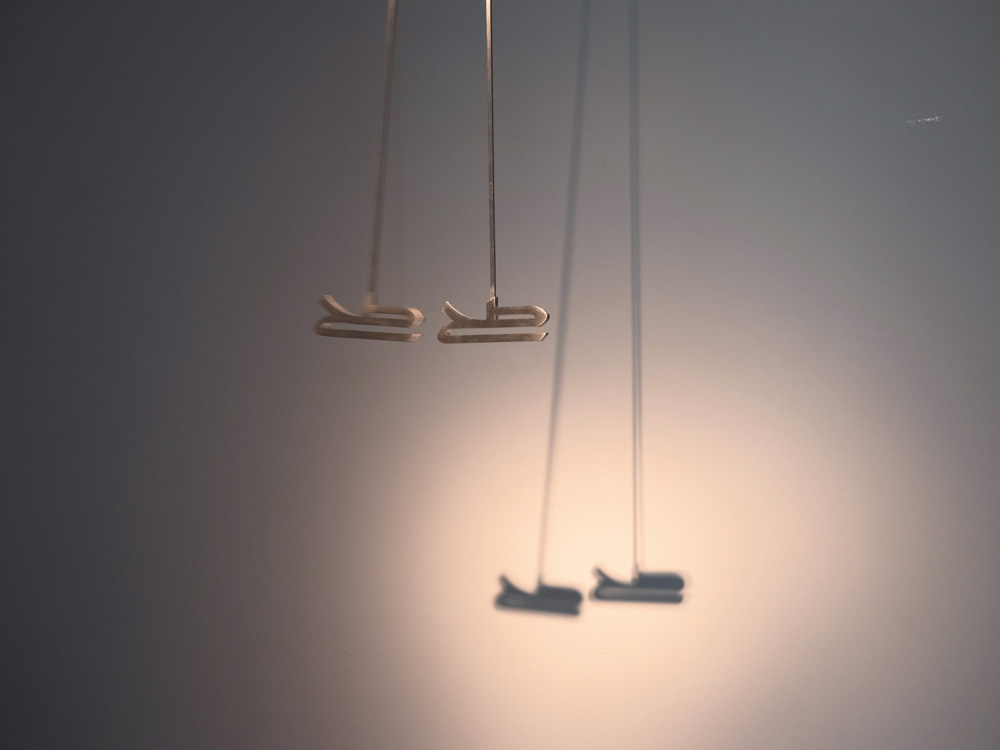
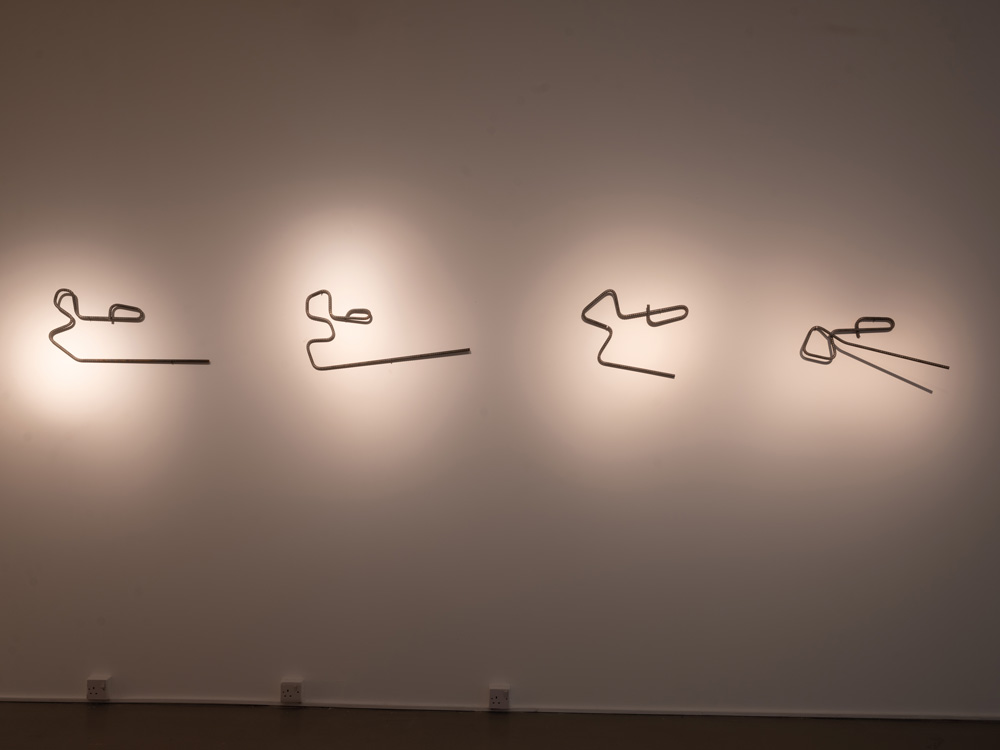

The language isn’t always neutral… the word “Right” might be interpreted as “Not wrong”, and the word “Man” could mean “Not woman”, and so on.
The artwork of the pendulum that is moving in two opposite directions, both of which bear the word “sah – right”. The viewer may think that there are no other words but the void that is generated in this movement when the two words separate; which is indeed terrifying.
Reversing Concepts to Correct Them
Shamma Al Amri’s solo exhibition “So to Speak” brought upon us many new artistic significations, some might even be presented for the first time, on a visual artistic level. Within such significations, meaning and shapes overlap, so does the color with the word, the language with silence, and mass with space. Tashkeel Dubai, which hosted the gallery in September 2022, stated that the artworks presented in the exhibition were a culmination of the artist’s participation in Critical Practice Programme organized by Tashkeel, as she was the fourteenth participant in the program.
Critical Practice Programme, one of the initiatives of Tashkeel Center, allows the contemporary artists residing in the UAE to receive the support they need; the Center’s studio, critique, and production, for one year. The program is usually concluded by an art exhibition or publications or any type of physical or digital issue. Every artist gets a program that is designed to fit him perfectly and suit his artistic skills and fields of research.
What is unique about this artist, and what raises questions about her work is her way of mixing different methods and various tools in her visual expressions, one of which is language. Shamma Al Amri does bring up Arabic words and linguistic connotations and utilizes the letters in calligraphy and in some paintings in a way where she relies on the aesthetics of font and letter; however, she also uses words to produce new visual concepts. She has used, in previous exhibitions, words with deep significations to express her vision. An example is the word “Exit مخرج” which she introduced in various ways at an earlier exhibit, or the word “Thinking تفكير” in which she deliberately resorts to the connotations of other words that have numerous derivatives, thus always raising questions for the viewer.
A Trap of Two Contradictories
In this generic exhibition, Shamma chose to focus her search on a single one root in the Arabic language to convey that something is right which is the word “Sah”. With that, she’s immediately pushing the viewer to fall right into the question of truth and existence, as this word represents the essence of what philosophers have long sought to find since we always live and think, and search for the difference between what’s right and wrong, and humans culture, throughout their history, have been revolving around these two baffling questions; what is right and what is wrong? Due to the obscurity of meaning, the labyrinth of connotations, and the differences, our mankind is doomed to live his eternal bewilderment and contradictories, all because of those two concepts.
The Deconstruction Methodologies believe that language isn’t always neutral, so when we write or draw the word “right – Sah” we inevitably invite its contradictory, even if not written. So that “right – Sah” might be interpreted as “Not wrong”, and the word “Man” could mean “Not woman”, and so on and so forth in this endless derivation of words and connotations that define the meaning. I don’t want to go on and on about this lexical aspect, instead, I want to capture the essence and human aspect that is manifested in Shamma Al Amri’s artwork when she puts us face to face with a word this huge, with all its connotations and references to many other meanings, all in a space charged with uncertainty, and deliberate demolishing of significations and ideas, where the passing time is the only constant in her solo exhibit, and by time we mean that moment through which we change whenever we face another angle, just like the sun rays change angles from moment to another.
The Dominance of the Sacred
Shamma’s passion also takes her as far as to experiment on that same concept and the same word “right sah”. In the beginning, she was inclined to discover how this word relates to itself and her inner self, and what it exactly means to her. Shamma has perhaps heard this word a million times within her conservative social circle since she, as a girl, should always do, say, wear, and think of what’s “right – sah”. It is a sacred word to which everyone should submit, and for any deviation away from this “right”, the cost could be her life. However, in her art practice, the artist couldn’t set the tone of this moral and social condition. She went on to handwrite the word “right – sah” a thousand times, yet all of them came wrong, imperfect, and none of them resembled the other. Then she went on to the newspapers, books, and publications, without being able to find what could quench her thirst, as the word “right – صح” does not appear in the historic and Islamic heritage books, but it comes up as a part of words in contexts that have an adjacent meaning. You can find (“journalism – صحـافة” and its derivatives, “desert – صحـراء”, “true – صحـيح”… etc.) yet the word “right – صح” rarely stands alone, even in poetry, but it is a word that describes half of our existence, it is the equivalent of good and evil, and right and wrong. Its significations goes further to include the whole human body, since the word “health – صحــة” has the same root, and any malfunction in “health – صحــة” means illness and death.
Breaking the Oath
In the artwork called “Artist’s Oath”, the artist practices what could be a deliberate demolish of time continuity. As she gathers logs, ideas, and words to declare some kind of manifesto or binding oath to which the artist should adhere. However, when the big picture unfolds, she decides that such practice is not “right” so she eventually suspends all the written terms, duties, and values to which the artist should adhere, this is after realizing that the artist is not a doctor, nor a lawyer, to set limits and restricts of any kind for himself, as art is not a job in the first place but overwhelming loose waves outside the streams of commitment, whatever kind it is. The artist, instead, is an advocate for an imagined concept called freedom, which is exactly what Shamma is doing in that exhibition, she speaks of freedom as a dream, she writes, logs, and presents ideas of what an artist should abide by, but eventually, they all vanish as unattainable goals. When we perceive the displayed piece, nothing is clear and we don’t see but static meanings that are neither right nor wrong.
Through this exhibition, Shamma Al Amri presents her own vision of existence, of the meanings that control us, of the idea of right and wrong. She simply introduces this new concept through which we can observe the overlapping of contradictories and the risk of being deceived by form, at the expense of meaning.
The dreadful void gap
Shamma orchestrates the word “Sah – right” in its risky linguistic connotations, and its contradictory is not only “wrong” but is all that is prohibited, rejected, shameful, and not allowed, and another contradictory is the word “No” and whatever other meanings this may hold. Let us take for example the work of the moving pendulum in two opposite directions, both of which bear the word “sah – right”. This eternal cross-pollination between the word and its identical twin, generates a third concept in the mind. When we combine ‘sah’ (right) and ‘sah’ (two words that separate and come back to unite in an endless movement), the viewer may think that there are no other words but the void that is generated in this movement when the two words separate; which is indeed terrifying. It is greater than the concept of ‘right’ or a suggestion of ‘sah seh’ (wake up, playing with the word ‘right’) when the two words meet together. Yet when they are apart, the emptiness here seems like an abyss that swallows everything. Once again, Shamma tries to draw some features of the philosophy of time in this artwork. However, for me, it is the philosophy of mass and emptiness; the mass of significance generated by the word and the infinite emptiness that surrounds them. There is then this social pattern that we must pay attention to, and if we were to contemplate the meanings that this exhibition conveys, we would unveil the fact that what we perceive in front of us is actually a practice that exposes the reality hiding behind those values, and dig deep within the people’s perception of what they think of as right, which is, in fact, a chain for their freedom and humanity.
Reversing Concepts
Why did Shamma choose to go to punitive institutes and ask the inmates to produce the word “Sah – right” in a creative way when those, in particular, being inmates at punitive institutes, are accused of doing the “Wrong”? why did she resort to construction workers, whose job is to lay out the correct foundations, and ask them to write the word “Sah” in steel, so the resulting product was uncoordinated letters, closer to being wrong? When the viewer walks across the exhibition aisles, he witnesses the transitions when identifying some of the “Sah” words that are perfectly written, to the ones that are distorted and bent, or the ones that are simply imperfect. With that, she wants to dismantle the deep-rooted beliefs, those of the viewer, by showing that humans are always captive to the contradiction between a word and its opposite, but there, within the details, a wide space of overlapping and entanglement between the two contradictories, so that the right could turn into wrong at any second, and vice versa, or you might intend to do what’s right, but the ending results could be the exact opposite.
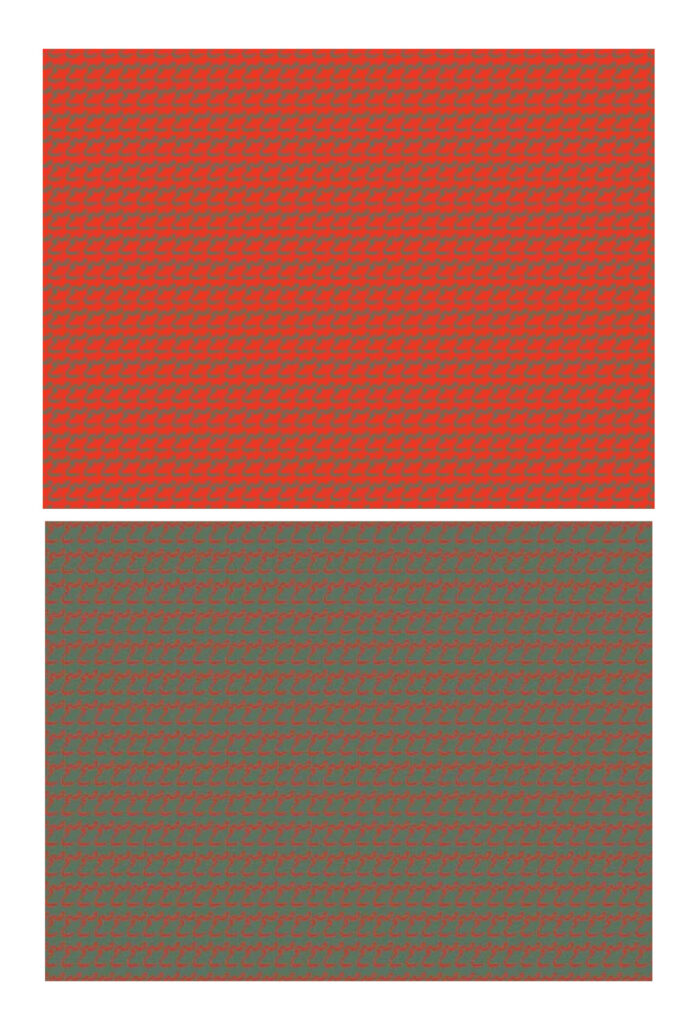
The Deceiving Form
Visual art has always been a prisoner of form at the expense of meaning. However, recently, the modern schools of art have tended to venerate the concepts and ideas, where the skill alone is no longer enough without having this deep awareness from which the contemporary artist springs. Through this exhibition, we find that Shamma Al Amri presents her own vision of existence, of the meanings that control us, of the idea of right and wrong. She simply introduces this new concept through which we can observe the overlapping of contradictories and the risk of being deceived by form, at the expense of meaning.
The exhibition was curated by Huda Smitshuijzen AbiFarès, a typographer, writer, and graphic designer, and Mohammad Kazem, the Emirati artist. The art pieces were displayed on various types of mediums; metal, wood, ink on paper, and UV printing on plexiglass.
Even if not declared publically, both the political aspect and the social-cultural aspect overlap in this exhibition. We can feel the clear daring nature of the way she approaches art from a local, Arab, and Islamic cultural perspective. She does not try to appeal to the western taste, which may not be able to comprehend the signification of the word “Sah” and its psychological dimensions; something that she has practiced before in previous works and exhibitions, in which she used Arabic words and connotations. This confirms her desire to generate a unique concept for her artistic practice, one that stems from the depth of her cultural and cognitive background. We don’t get to witness that among many, those who are tempted by the trending art, and follow it blindly captive by the form at the expense of the meaning. She approaches the unspoken, and she carefully dives into an ocean of socially and philosophically contentious questions, so instead of settling for the creative colorful aesthetics and visual formations that could only be pleasing to the eye, she reaches for a higher form of enjoyment, one of the mind, that immerses the viewer, thus continuously generating new concepts in his mind.

The opening ceremonies were indeed incredible at Tashkeel Center established by Lateefa bint Maktoum in 2008. Tashkeel seeks to provide a nurturing environment for the growth of contemporary art and design practices. The Center also enables creative and experimental practices and dialogue among practitioners and their wider community by providing multi-disciplinary studios, workspaces, and galleries located in Nad Al Sheba and Al Fahidi. Operating on an open membership model, Tashkeel’s annual programme of training, residencies, workshops, talks, exhibitions, international collaborations, and publications aims to further practitioner development, public engagement, lifelong learning, and the creative and cultural industries.
References
1. Shamma Al Amri: Pace. 2022. Steel and magnetic bearings. 180 x 15 x 6 cm. Edition of 3. courtesy of the Artist.
2. Shamma Al Amri : Bending Directions (Abubaker, Abdulrahman). 2022. Hand-bent metal rod made by construction workers. Various dimensions.
3. Shamma Al Amri : The Artist’s Oath. 2022. UV on plexiglass, 21 x 29.7 x 12 cm, courtesy of the Artist.
4. Shamma Al Amri: Restricted Directions. 2022. Hand-cut wood by inmates of The Punitive and Correctional Institute, Dubai.Variable dimensions. courtesy of the Artist.
A poet and writer from the 80s generation in UAE, he has published several books about art, poetry, theatre, and novel, including: “In light and shadow, and between them life”, a study on visual arts in the Emirates - Sharjah 2000.

